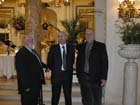 I met friends in London and on Saturday we went to have high tea at the Ritz Hotel . It
was quite an event. The meal took about 2 hours and was very formal with little
sandwiches and pastries.
I met friends in London and on Saturday we went to have high tea at the Ritz Hotel . It
was quite an event. The meal took about 2 hours and was very formal with little
sandwiches and pastries.
|
|
|
 I met friends in London and on Saturday we went to have high tea at the Ritz Hotel . It
was quite an event. The meal took about 2 hours and was very formal with little
sandwiches and pastries.
I met friends in London and on Saturday we went to have high tea at the Ritz Hotel . It
was quite an event. The meal took about 2 hours and was very formal with little
sandwiches and pastries.
I love London and usually stay at the Regent Palace, which is just off Piccadilly Circus1. There is a big advantage to being in the center of London: All the Night busses end up near the Piccadilly Circus so I can get home if I go out sleazing, and I do. London has a great night life that never ends. At night you can go to a disco in that holds thousands of people or party all night at a café in a cave under the train tracks.
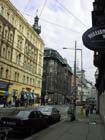 The next Monday I flew to Prague and stayed in a nice one star hotel called the Imperial .
Only two weeks to Easter, so there were painted and decorated egg shells everywhere.
They covered trees with the eggs . I also went to a performance of the
Image Theater (a
The next Monday I flew to Prague and stayed in a nice one star hotel called the Imperial .
Only two weeks to Easter, so there were painted and decorated egg shells everywhere.
They covered trees with the eggs . I also went to a performance of the
Image Theater (a
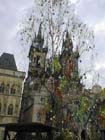 black light theater)(Appendix I). That was very inexpensive and very good. Naturally I
did the Tourist thing but I will not bore you with that, except to say the Clock in the Staré
Méstro was as fantastic and the tour books said.
The Charles Bridge is another wonder.
It was started with the foundation stone laid on July 9, 1357 at 5:31 AM personally
assisted by Charles IV. (Appendix II)
The food was very good. Unfortunately Central Europe does not understand salad. The
best they could do was cucumbers with vinegar or sour cream on them. Occasionally
some sliced tomatoes done the same way.
black light theater)(Appendix I). That was very inexpensive and very good. Naturally I
did the Tourist thing but I will not bore you with that, except to say the Clock in the Staré
Méstro was as fantastic and the tour books said.
The Charles Bridge is another wonder.
It was started with the foundation stone laid on July 9, 1357 at 5:31 AM personally
assisted by Charles IV. (Appendix II)
The food was very good. Unfortunately Central Europe does not understand salad. The
best they could do was cucumbers with vinegar or sour cream on them. Occasionally
some sliced tomatoes done the same way.
The one thing they did have were little open sandwiches that had everything from ham salad to caviar on them. They were very cheap (3 for a dollar) and 3 were enough for a good lunch. Dinner was often a bowl of Goulash. Every restaurant had their own recipe for this stew, but the texture and color were surprisingly consistent in each city and town. Prague Goulash was thick and creamy. Vienna was more of bullion with meat and stew vegetables. The Hungarian version was spiced with their famous paprika. All versions were filling and wonderful to the pallet.
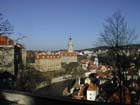 I took a bus to
Cesky Krumlov2
the next Monday and saw most of Bohemia on the trip.
Thee hours on a very nice bus, I did not like Cesky Krumlov very much because it was
cold and the place I was staying did not let me leave my luggage and go exploring till 3
PM. It did have a nice Castle (Cesky in Czech) and was very quaint.
I took a bus to
Cesky Krumlov2
the next Monday and saw most of Bohemia on the trip.
Thee hours on a very nice bus, I did not like Cesky Krumlov very much because it was
cold and the place I was staying did not let me leave my luggage and go exploring till 3
PM. It did have a nice Castle (Cesky in Czech) and was very quaint.
My great adventure was the next day getting from Cesky Krumlov to Austria. There was no direct connection to the border. I had to take a local bus to the train station and then a train to Linz in Austria. I had to take a local bus to the train station at Kaprice to get the train. Unfortunately the bus did not stop at the station bus a block away and I did not know I was to get off. The bus continued on to the center of Kaprice many kilometers from the train station. No one spoke any English or German. One older lady finally recognized my plight and told the driver to take me to the next train station at Rybnik. That took another hour but I still caught the last train to Linz. (There are 3 every day.) It took the train about one hour to get to the border (30 Km) where I had to change to an ÖOB train and on to Linz.
The Iron Curtain is still a very real thing for the people in this area of Europe. It was amazing the difference the border made. First I could speak to people. That was a big thing. In the middle of Bohemia very few people speak anything but their own dialect of Czech. Then everything in Austria was spick and span and functioning. Even the train was far superior once you crossed the border. It took half the time to cover twice the distance. The conductor was my first experience with the Austrians and he was so nice and friendly, that he suggested I get a ticket all the way to Vienna and that I could stop in Linz on the way. That saved me a couple Euros.
I visited the "Ars Electronica Center" in Linz and walked around town a bit. The Center was fascinating and really tried my German knowledge. The older men were having a game of chess with life size chess pieces in the town square. I hopped on a train and was in Vienna in two hours (200Km). A short U-Bahn and bus ride, and I was at my apartment.
The apartment was a cute little place on the ground floor of an apartment building near a
large park called the Prater, so I enjoyed walks in the park. It was wonderful and only a
block to the bus to Karlsplatz (a webcam in Karlsplatz),
or the N tram to Schwedenplatz. The center of town
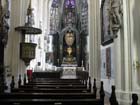 Stephansplatz with St. Stephan's Church is only a few interesting blocks away from
Karlsplatz or Schwedenplatz. I saw all the great palaces and did the tourist thing
including the Spanish Riding School. I am enclosing a picture of the inside of Maria Am
Gestade (St. Mary's on the Riverbank) , which is representative of many of the beautiful
churches in Vienna.
Stephansplatz with St. Stephan's Church is only a few interesting blocks away from
Karlsplatz or Schwedenplatz. I saw all the great palaces and did the tourist thing
including the Spanish Riding School. I am enclosing a picture of the inside of Maria Am
Gestade (St. Mary's on the Riverbank) , which is representative of many of the beautiful
churches in Vienna.
My English friends made it down to Vienna for Easter Weekend and we went to Sacker Hotel Restaurant for coffee and a quick tour of the inner Ring area of Vienna. We also walked thought the grounds at Belvedere Palace.
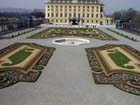 The most impressive was Schloss Schönbrunn . It was a combination of palace, zoo
botanical garden and hunting preserve. I was also able to get up into the Vienna Woods
over one weekend and ate roasted chestnuts while looking down the Danube Valley.
Despite the song "Ach Du Lieber Augustine"
I could live in Vienna.
The Danube, Donau, Duna is the lifeblood of central and Eastern Europe. Ten countries
share its water; Germany, Austria, Slovakia, Hungary, Czech Republic, Slovenská
Republika, Bulgaria, Romania, Moldova and Ukraine. After several glorious weeks in
Vienna I had a great boat trip down this magnificent river past Bratislava and Esztergom
(the ancient capital of Hungary) to Budapest. It was a fantastic voyage through the
heartland of Europe. We passed through two sets of locks in Austria and then into open
farm and woodland dotted with small fishing huts.
The most impressive was Schloss Schönbrunn . It was a combination of palace, zoo
botanical garden and hunting preserve. I was also able to get up into the Vienna Woods
over one weekend and ate roasted chestnuts while looking down the Danube Valley.
Despite the song "Ach Du Lieber Augustine"
I could live in Vienna.
The Danube, Donau, Duna is the lifeblood of central and Eastern Europe. Ten countries
share its water; Germany, Austria, Slovakia, Hungary, Czech Republic, Slovenská
Republika, Bulgaria, Romania, Moldova and Ukraine. After several glorious weeks in
Vienna I had a great boat trip down this magnificent river past Bratislava and Esztergom
(the ancient capital of Hungary) to Budapest. It was a fantastic voyage through the
heartland of Europe. We passed through two sets of locks in Austria and then into open
farm and woodland dotted with small fishing huts.
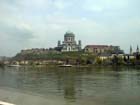 Bratislava has a fantastic bridge with a restaurant on top of its tower . The only problem
is that it sways in the wind.
Esztergom is a
fantastic city to approach on the river. You
first see a dome and then the city spreads out on the hill behind it. Only a short distance
beyond is Vac and then Budapest.
Bratislava has a fantastic bridge with a restaurant on top of its tower . The only problem
is that it sways in the wind.
Esztergom is a
fantastic city to approach on the river. You
first see a dome and then the city spreads out on the hill behind it. Only a short distance
beyond is Vac and then Budapest.
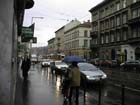 It was wintry in Prague but by the time I got to Budapest it was summery. I am enclosing
a picture of a rainy day on Vámház körút, the street in front of my room in Budapest.
This is a cheerier view.
There were some spectacular thunderstorms while I was there. I misread the boat
schedule and arrived 2 hours early. I had a big problem finding change to make a phone
call to get the keys to my room but I finally went to the bank and changed a 200 HUF bill
(about $1) into coins and made the call.
It was wintry in Prague but by the time I got to Budapest it was summery. I am enclosing
a picture of a rainy day on Vámház körút, the street in front of my room in Budapest.
This is a cheerier view.
There were some spectacular thunderstorms while I was there. I misread the boat
schedule and arrived 2 hours early. I had a big problem finding change to make a phone
call to get the keys to my room but I finally went to the bank and changed a 200 HUF bill
(about $1) into coins and made the call.
Just as in Prague everything is cash in Budapest. The bank machines are the only place that I could use plastic. This lead to a problem of paying for the room and finding a bank machine that would accept my card. So my first day in Budapest was a double panic in the rain. I was very lucky to be traveling light.
Pest is the castle side of town, with hills and wonderful scenery. Buda is the flat part that extends into the Hungarian plain, and is the more industrial part of town. The Hapsburgs put a castle up in Budapest just like they did in Prague and Vienna. The Gellert hotel had a wonderful thermal bath. Another Thermal bath was called Kiralyfurdo or Kiraly (Kings) Baths. This was originally constructed by the Turks inside the Pest city wall to make sure they stayed clean in the event of a siege. I do not think it has been cleaned since the Turks left in 1500 something.
Before I left for the airport, I went to the huge market place a block away from the room and found all kinds of good eats and trinkets.
Appendix I Black-Light Theatres
The original principles of black-light theatre, illusory creations, altered reality perception,
the revealing of the hidden secrets of things and the magic world of their transformations,
mime and modern dance are today offered by black-light theatres in various variations.
Black-light Theatre of F. Kratochvíl bears the name of the painter and graphic artist
whose creations are brought to life in all performances. Image Theatre combines the
principles of black-light theatre, mime and ballet. Black light theatre of Jirí Srnec - Srnec
was one of the founders of black-light theatre - uses mime communication and the
attractiveness of technical procedures. Ta Fantastika Theatre combines specific black-
light theatre effects and animated film with live actors. A new musical project of ACT
Theatre uses the old legend and draws on the tradition of Czech puppet plays.
Black theatre is different; the light is different and the dark is different. The intense darkness of black theatre is full of fantasy. Poetic pictures are approaching you from the mysterious and almost indefinite depth of a black cabinet. You cannot see the actors, as they are invisible. Suddenly you can see them rather well and almost dangerously close. Dance will express the unspoken, disturb emotions and overcome laws of physics. Music will bring inanimate to life, tragic will change into comic, unbelievable will become real. And, moreover, your imagination will fully awake.
Appendix II Charles Bridge
Charles Bridge (Czech: Karluv most) is a famous historical bridge crossing the Vltava
River in Prague, Czech Republic. Its construction started in 1357 under the auspices of
king Charles IV. As the only means of crossing the river in Prague, Charles Bridge used
to be the most important connection between the Old Town, Prague Castle and adjacent
areas till 1841. The bridge was originally called the Stone Bridge (Kamenný most) or the
Prague Bridge (Praský most) and is known as "Charles Bridge" since 1870.
The bridge is 516 meters long and nearly 10 m wide, resting on 16 arches shielded by ice
guards. It is protected by three bridge towers, two of them on the Lesser Quarter side and
the third one on the Old Town side. The Old Town bridge tower is often considered to be
one of the most astonishing civil gothic-style buildings in the world. The bridge is
decorated by a continuous alley of 30 statues and statuaries, most of them baroque-style,
erected around 1700.